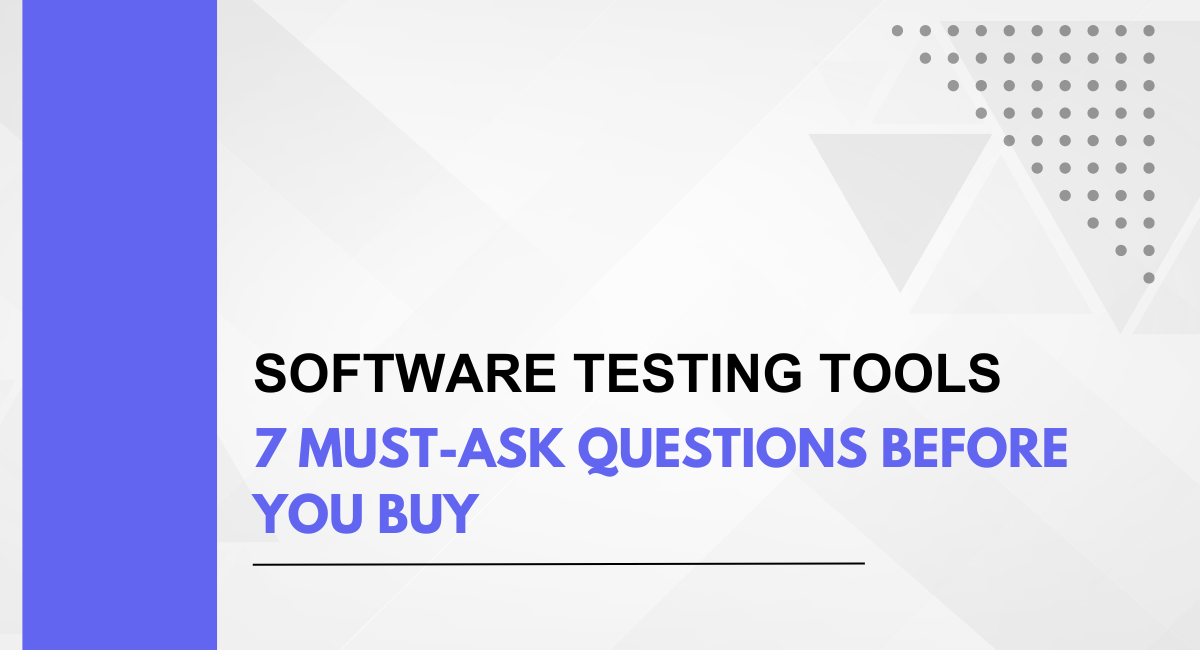Software testing plays a crucial role in identifying defects, verifying functionality, and validating that applications meet the specified requirements. Without effective testing, software releases may contain critical bugs that can lead to system failures, security vulnerabilities, and dissatisfaction among users. A comprehensive software testing strategy is essential to delivering high-quality software that meets user expectations and industry standards.
Why Choose the Right Software Testing Tool?
Impact of Testing Tools on the Software Development Lifecycle
Practical software testing tools play a crucial role in shaping and optimizing the software development lifecycle (SDLC). The proper testing tools can significantly enhance the efficiency of development processes, leading to faster releases and higher-quality software. Automation tools, for example, can expedite the execution of repetitive test cases, allowing developers to focus on more complex and critical aspects of application functionality.
Testing tools also contribute to early bug detection, reducing the chances of defects reaching the production stage. By integrating testing into various phases of the SDLC, organizations can identify and rectify issues promptly, preventing costly rework and ensuring a smoother development process.
Furthermore, testing tools facilitate collaboration between development and quality assurance teams. They provide a standardized platform for communication and reporting, fostering a more transparent and efficient workflow. This collaboration is essential for achieving a balance between speed and quality in software development.
Cost Implications of Choosing the Wrong Tool
Selecting the wrong software testing tool can have significant financial repercussions for an organization. The costs associated with incorrect tool choices include not only the initial investment but also expenses related to training, maintenance, and potential project delays.
Ineffective tools may require extensive customization or integration efforts, consuming valuable resources and time. Additionally, a tool that does not align with the organization's needs may result in decreased productivity and increased manual intervention, negating the intended benefits of automation.
The financial impact extends beyond the direct costs of the tool itself. Suppose a tool is not capable of effectively identifying and preventing defects. In that case, the organization may incur expenses related to post-release bug fixes, customer support, and potential damage to the company's reputation.
Importance of Aligning Testing Tools with Specific Project Requirements
Not all software testing tools are created equal, and each project has unique requirements that necessitate a tailored testing approach. Choosing a testing tool that aligns with specific project needs is essential for maximizing its effectiveness.
Considerations such as the nature of the application, technology stack, scalability requirements, and the level of test automation desired should guide the selection process. By understanding the project's testing requirements, organizations can avoid investing in tools with unnecessary features or, conversely, tools that lack critical functionalities.
Aligning testing tools with specific project requirements also ensures that the tool seamlessly integrates into the existing development ecosystem. Compatibility with development frameworks, version control systems, and continuous integration tools is vital for a smooth and efficient testing process.
The anticipated expansion of the Global Software Testing Tool Market is from USD 2317.59 Million in 2022 to USD 3952.38 Million by 2030, with a Compound Annual Growth Rate (CAGR) of 6.9% throughout the forecast period (2023–2030).
7 Must-Ask Questions Before Buying Software Testing Tools

What Are Your Testing Objectives?
- Functionality Testing: Ensure that the software functions according to the specified requirements.
- Performance Testing: Evaluate how well the system performs under different conditions, including load testing, stress testing, and scalability testing.
- Security Testing: Identify and address vulnerabilities in the system to prevent unauthorized access and protect data integrity.
- Usability Testing: Assess the user interface and overall user experience to ensure it meets user expectations.
- Compatibility Testing: Ensure the software works correctly across different devices, browsers, and operating systems.
- Reliability Testing: Verify that the software is stable and reliable over time, with minimal crashes or failures.
- Regression Testing: Confirm that new changes or updates do not negatively impact existing functionalities.
- Accessibility Testing: Ensure that the software is accessible to users with disabilities.
Is It Compatible with Your Tech Stack?
- Operating System Compatibility: Ensure that the testing tool supports the operating systems used in your development and production environments.
- Browser Compatibility: If your application is web-based, confirm that the testing tool is compatible with the browsers your users are likely to use.
- Database Compatibility: Check if the testing tool works seamlessly with the databases employed in your application.
- Version Control Integration: Verify if the testing tool integrates with your version control system (e.g., Git, SVN) to facilitate collaboration and version tracking.
- Continuous Integration/Continuous Deployment (CI/CD) Integration: Ensure that the testing tool can be seamlessly integrated into your CI/CD pipeline for automated testing.
- Issue Tracking Integration: Check if the testing tool integrates with your issue tracking or project management system for efficient bug tracking and management.
- Programming Language Support: Confirm that the testing tool supports the programming languages used in your project (e.g., Java, Python, JavaScript).
- Framework Compatibility: If your application relies on specific frameworks (e.g., React, Angular, Spring), ensure that the testing tool can work seamlessly with them.
- API Compatibility: If your application communicates through APIs, check if the testing tool supports the relevant API protocols (e.g., REST, GraphQL).
How User-Friendly is the Interface?
- Productivity: A user-friendly interface enhances the efficiency of the testing process, allowing testers to focus on their tasks without struggling with complex tools.
- Reduced Learning Curve: Testers can quickly familiarize themselves with the tool, reducing the time and effort required for training.
- Minimized Errors: Intuitive interfaces help prevent user errors, reducing the likelihood of mistakes during the testing process.
- Increased Adoption: Testers are more likely to embrace and adopt tools with user-friendly interfaces, leading to better collaboration and communication within the testing team.
- Time and Cost Savings: An easy-to-use interface reduces the time spent on training and troubleshooting, contributing to overall time and cost savings in the testing process.
What is the Tool's Scalability and Performance?
- Load Testing: Evaluate how the testing tool performs under different loads and stress levels to ensure it can handle the expected workload of your testing scenarios.
- Concurrency: Assess the tool's ability to handle multiple users or test executions concurrently without significant degradation in performance.
- Response Time: Measure the response time of the tool for various actions to ensure it meets the required performance standards.
What Support and Community Resources are Available?
- Support Channels: Evaluate the availability of customer support channels such as email, phone, live chat, or a ticketing system.
- Response Time: Assess the responsiveness of the customer support team by checking average response times and turnaround for issue resolution.
- 24/7 Support: Consider whether the support team operates 24/7, mainly if your testing team is distributed across different time zones.
- Community Forums: Check if there is an active user community or forums where users can ask questions, share experiences, and seek advice.
- Engagement Level: Assess the level of engagement within the community, including the frequency of discussions, responses to queries, and the overall vibrancy of the forum.
- Contributions from Developers: Look for contributions from developers, as a thriving community often involves active participation from both users and the tool's developers.
- User Reviews: Read user reviews on various platforms to understand the experiences of other users with the testing tool.
- Testimonials: Look for testimonials from organizations or testing professionals who have successfully used the tool for their projects.
- Social Media Presence: Check the tool's social media presence for feedback, comments, and discussions about the tool.
What is the Total Cost of Ownership (TCO)?
- Licensing Model: Determine the type of licensing model the testing tool follows, whether it's a subscription-based model, perpetual licensing, or usage-based pricing.
- License Tiers: Understand if the pricing is tiered based on features, the number of users, or the scale of usage.
- Renewal Costs: Consider any renewal costs associated with maintaining access to updates, support, and new features.
- Additional Modules or Features: Check if some other modules or features incur extra costs and assess whether they are necessary for your testing requirements.
- Training Costs: Factor in any costs associated with training your testing team to use the tool effectively.
- Integration Costs: Consider costs related to integrating the testing tool with other tools or platforms in your development environment.
- Feature-to-Cost Ratio: Evaluate the features offered by the testing tool in relation to its cost to determine the value it provides.
- ROI (Return on Investment): Assess the potential return on investment by considering the tool's impact on productivity, efficiency, and the overall quality of your software.
- Long-Term Considerations: Consider the long-term costs, including maintenance, updates, and scalability, to ensure that the tool remains cost-effective over time.
Does It Meet Security and Compliance Standards?
- Industry Standards: Verify that the testing tool complies with relevant industry standards and best practices for software testing and development.
- Regulatory Compliance: Ensure that the tool aligns with any specific regulations applicable to your industry, such as GDPR, HIPAA, or other data protection laws.
- Data Encryption: Confirm that the testing tool employs encryption protocols to secure data during transmission and storage.
- Access Controls: Evaluate the tool's access control mechanisms to ensure that only authorized personnel can access sensitive information.
- Authentication and Authorization: Check for robust authentication and authorization processes to prevent unauthorized access to the testing tool and its data.
- Audit Trails: Ensure that the tool maintains detailed audit trails, allowing you to track and monitor user activities and system events.
- Privacy Policies: Review the tool vendor's privacy policies to understand how they handle and protect user data.
- Data Retention Policies: Check for data retention policies within the testing tool to ensure that data is not stored longer than necessary.
- User Consent: Confirm that the tool provides features to obtain and manage user consent where applicable, especially in cases involving personal or sensitive data.
Critical Decision
Selecting the right software testing tool is a critical decision that directly influences the success of software development projects. Before making any decisions, readers are encouraged to conduct a thorough assessment of their project requirements. Understand the specific needs of your development environment, the nature of your applications, and the scale of your projects.
By aligning the chosen testing tool with these requirements, you increase the likelihood of a successful implementation that enhances the efficiency and quality of your software development process.
You may also be interested in API Testing Automation: Key Insights for Success - Part 2
Book a Demo and experience ContextQA testing tool in action with a complimentary, no-obligation session tailored to your business needs.
We make it easy to get started with the ContextQA tool: Start Free Trial.
